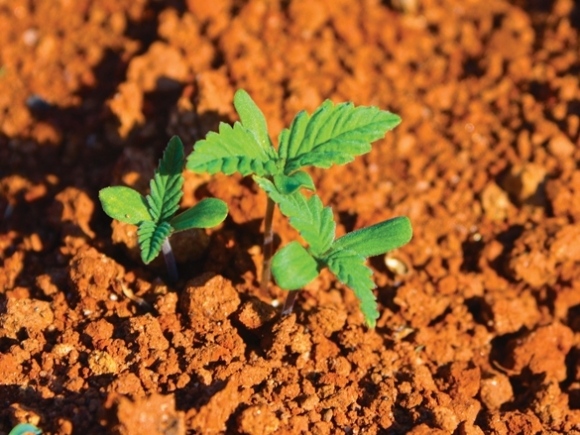What’s in the cards? Growing the greens

The cultivation of agriculture is the first and most important way Homo sapiens differentiate themselves from other creatures.
It’s literally been that important, for thousands of years.
Safe, efficient and reliable food production is still the cornerstone of any organized society and makes possible population increases that grow economies and create wealth.
 It’s been no different in Haywood County; since the region was first settled by the Cherokee and then later by Europeans, agriculture has been an important economic sector that not only feeds families but also generates millions of dollars in sales each year.
It’s been no different in Haywood County; since the region was first settled by the Cherokee and then later by Europeans, agriculture has been an important economic sector that not only feeds families but also generates millions of dollars in sales each year.
Modern agriculture, however, is far removed from the small Cherokee villages and simple family homesteads of the Cataloochee Valley’s yesteryear; industry consolidation throughout the last half of the 20th century corporatized agriculture more than ever before.
Now, with large-scale agriculture disappearing across the county and across the country, small-scale niche producers face challenges in both delivering and producing new products while competing with growers half a world away.
Related Items
But Haywood County is doing all it can to augment its diminishing but still robust agricultural industry; the presence of a cattle market, a consumer program and a research station all point to a countywide commitment towards growing greens – not just the rubbery leaves of Burley tobacco, but cold hard cash.
Paid by the pound
Just east of downtown Waynesville, off the aptly-named Test Farm Road, sits 400 acres on which Kaleb Rathbone’s been stomping around for years.
“I started working here in high school,” Rathbone said.
Rathbone graduated from Tuscola High School, earned his bachelor’s degree in environmental and soil science from the University of Tennessee-Knoxville, earned a master’s degree in agricultural operations from UT-Martin, and is now the superintendent of the North Carolina Department of Agriculture and Consumer Services Mountain Research Station.
“Our research program is divided between crops and livestock,” he said. “Everything from Christmas trees, row crops like corn and soybeans, a lot of horticulture work, tomato breeding, broccoli, peppers …. Pretty much if it’s grown in this area, we are or have done research on it.”
Beef, he said, is still the largest segment of agriculture in Western North Carolina.
“It’s a product of our topography. You can’t grow corn or soybeans on the side of that hill,” he said, pointing in the direction of the rolling knolls that hug the research station’s perimeter. “You use what you’ve got.”
That cattle breeding research taking place at the MRS has benefitted producers; however, a bigger economic development challenge solved years ago by a small cadre of state and local economic development agencies has had far more impact on Haywood County’s agricultural sector than any fatted calf ever could.
As livestock markets in Canton and Asheville closed, Mark Clasby’s Haywood Advancement Foundation helped create the WNC Regional Livestock Center in Canton.
When cattle producers transport their cattle to distant markets, the cattle lose weight on the trip.
“You get paid by the pound,” Clasby said.
Keeping cattle here — as well as drawing cattle from across the region — creates an important hub of economic activity in a county where the number of animal and animal-related establishments has dropped by 46 percent from 1997 to 2012, according to the USDA.
Revenue over that period, however, dropped just 23 percent, indicating that the Regional Livestock Center has helped stem the loss.
Crop producers in Haywood County have over that same period seen a similar decline in the number of establishments — 34 percent — but also have seen revenue growth of 15 percent.
Some of that gain can probably be attributed to another Haywood Economic Development Council effort — Buy Haywood.
Begun in 2007, the grant-funded Buy Haywood Market Development Program connects local consumers with local producers that produce everything from tomatoes to honey to trout caviar while attempting to fuse agriculture and tourism into the burgeoning new industry of agritourism.
“It was started specifically to help get local tomatoes and peppers into grocery stores,” said Buy Haywood Project Coordinator Tina Masciarelli.
Masciarelli’s helmed the program, which runs on an extremely lean average budget of $10,000 to $15,000, for five years now; that tomato effort having proved successful inspired the group to branch out with a number of other marketing initiatives aimed and helping consumers put local produce on their tables — including newer products like beer and whisky.
“We’re always looking for new markets for Haywood County products,” she said.
Those products in turn are influenced by the work of Rathbone and the MRS.
“The majority of crop work we do is associated with plant breeding and genetic improvement,” he said. “There’s a large pocket of tomato production in this area. N.C. State has a tomato breeding program that’s pretty much dedicated to and focuses on Western North Carolina and the majority of the commercial varieties growers are using were developed here or at the station in Mills River.”
Tobacco remains an important but diminishing cash crop in the county, and as such, much research still takes place on the crop.
“North Carolina is still the largest tobacco-producing state, and still plays a very vital economic role in our state,” Rathbone said. “You don’t think about it, but farmers in Haywood County are in direct competition with growers in Brazil or Malawi or Mexico.”
In addition to perfecting the cultivation of old mainstays like tomatoes and tobacco, Rathbone’s got a new crop this year — one that hasn’t (legally) been planted in Haywood County in five decades or more.
“In the last farm bill there was a provision that allowed states to establish a research program for industrial hemp, state by state. Kentucky was one of the first ones and they’ve had it going for a while,” Rathbone said. “In North Carolina, I believe it was last year the General Assembly passed authorization for our state to form the Industrial Hemp Commission which was charged with the task of establishing a research program.”
A small crop of hemp seedlings — with tiny sawtoothed leaves — now dots the persimmon-colored soil at MRS.
“It’s very strict,” Rathbone said. “I had to send in the GPS coordinates on this particular field. If I were to grow hemp in a field right over there, it would be just like growing marijuana — it would be illegal.”
Rathbone’s hemp contains a very low amount of THC — the active ingredient in cannabis that produces the “high” — and can’t be used recreationally.
But it can be used for all manner of fibrous products, from paper to rope, and would be a rarity in the horticultural world — it’s not often a new crop makes an appearance in a farmer’s field.
Research at the MRS — which generates 70 percent of its yearly revenue from its own sales — can take anywhere from 5 to 15 years to finally reach consumers, but the industrial hemp has much further to go; Rathbone said that due to its illegality, it’s missed out on more than half a century of research that has benefitted other plants like tomatoes and corn.
“We don’t even know what soil pH is best,” he said.
As producers and growers in Haywood County look to the future of the industry, the biggest problems appear on a global and national scale; last spring, Haywood County Farm Bureau President Don Smart said that the major challenges in the industry aren’t pests or rainfall, but health care and immigration — specifically finding enough workers.
But with support from Rathbone’s MRS, Canton’s livestock center and Masciarelli’s Buy Haywood program, those local producers have all the encouragement they need to continue growing the greens.
“We can confidently say that we’ve helped boost sales,” Masciarelli said. “The anecdotes are overwhelming.”









